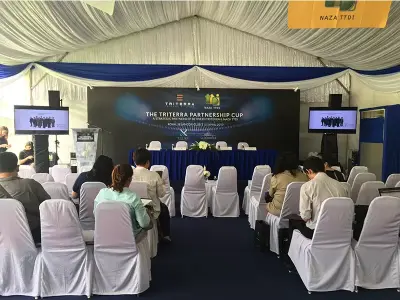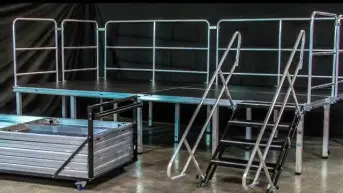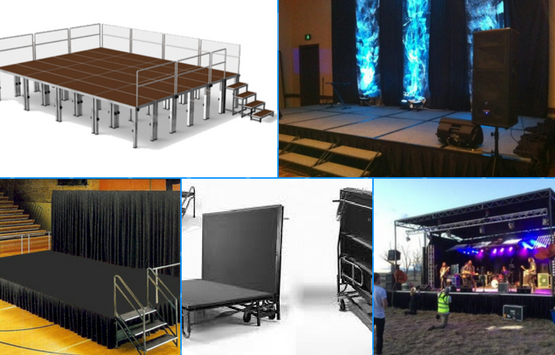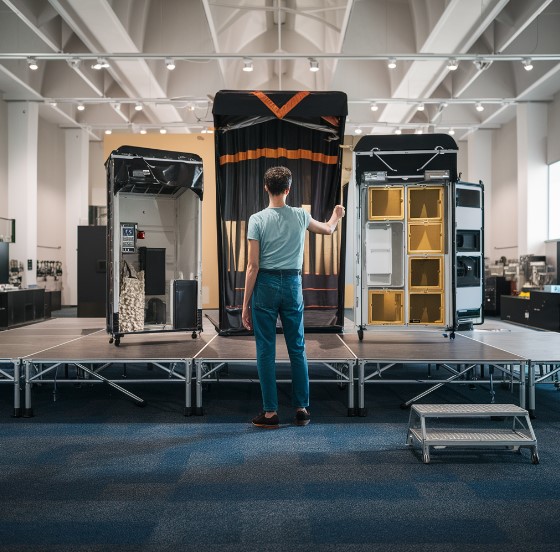Portable Stage Units: A Canvas for Events

Imagine a stage as a blank canvas that transforms into a vibrant masterpiece during events. From concerts, conferences, to community gatherings, the ability to swiftly and efficiently reshape spaces has made portable stage units indispensable.
They empower event planners to execute seamless performances while accommodating diverse venue requirements. This article delves into the nuances of choosing between purchasing or renting these versatile solutions, ensuring you select the optimal option for your event’s success.
Understanding Portable Stage Units
Portable stage units are akin to event Lego blocks—modular, versatile, and indispensable. They consist of platforms that are straightforward to assemble, disassemble, and transport.
The key components include risers, decks, braces, and guardrails. These together form a sturdy and adaptable stage. With these units, every setup is flexible, enabling configurations tailored to various event needs without compromise.
Why Opt for Portable Stage Units?

In the realm of events, mobility reigns supreme. Portable stages offer the following advantages:
- Portability: Unlike permanent stages, they are crafted for rapid setup and dismantling.
- Versatility: Ideal for events ranging from weddings to trade shows and theatrical performances. Their adaptable nature suits any setting.
- Cost-effective Solutions: With options to either rent or purchase, they can slash staging expenses considerably.
Noteworthy events using these units include music festivals, where a portable stage morphs into a concert arena, and conferences requiring swift assembly between sessions.
Key Components and Terminology
Understanding the anatomy of portable stages is crucial:
- Platforms and Risers: Form the stage’s surface and are adjustable to varying heights.
- Common Materials: Typically constructed from aluminum, steel, or wood, providing a spectrum of benefits in terms of weight, strength, and aesthetics.
Also Read: How NexGen’s Modular Stage Platform Revolutionised Our Club Events?
Renting vs. Purchasing Portable Stages
Decision-making in dealing with portable stages often narrows down to renting or purchasing:
Renting
- Pros:
- Economical for Short-term Use: Avoids a significant initial outlay.
- Flexibility: Offers a variety of sizes and styles without long-term commitment.
- Cons:
- Limited Customization: Options are often restricted by availability.
- Recurring Fees: Costs accumulate over time, especially with frequent usage.
Purchasing
- Pros:
- Tailored Customization: Ability to adjust stages to specific branding and specifications.
- Long-term Savings: Ideal for repeated use, significantly reducing costs over time.
- Cons:
- Higher Initial Cost: The upfront investment is more substantial.
- Storage Requirements: Challenges in finding storage space when stages are not in use.
Factors to Consider When Choosing Portable Stage Units

When selecting a portable stage, several crucial factors need consideration, such as:
- Cost Analysis: Critical to compare both rental and purchase expenses.
- Size and Material Considerations: Align stage size with venue capacity and material type with event nature.
- Customization Needs: Assess whether specific branding or unique configurations are needed.
Frequently Asked Questions
Q1: How should I choose between renting and buying a stage?
Determining whether to rent or buy portable stage systems involves evaluating event frequency, budget considerations, and projected needs. Renting is best for singular or infrequent events, minimizing initial costs. Buying becomes cost-effective for regular use, offering long-term savings and flexibility.
Q2: What are the typical costs involved in stage rentals?
Rental costs can vary widely, including:
- Base rental fees: Depending on the size and configuration.
- Delivery and setup charges: Often additional.
- Insurance: Optional but commonly recommended for damage coverage.
Q3: What factors influence a stage’s durability and stability?
Crucial factors comprising:
- Material of the platform: Opt for long-lasting materials like high-grade aluminum or steel.
- Structural Supports: Ensure risers and braces are robust and correctly secured.
Q4: How can I ensure the stage aligns with specific event needs?
Customization options include:
- Modifiable components: Adjust stage dimensions and shapes.
- Branded backdrops and finishes: Maintain brand consistency.
Q5: What logistics are necessary for transporting mobile stages?
Consider important logistics such as:
- Weight and Volume: To stay within transportation limits.
- Ease of Assembly: Focus on smooth, time-efficient setups.
Q6: What should I evaluate in vendors or suppliers?
Assess based on:
- Reputation and Reviews: Seek past customer feedback.
- Inventory and Quality: Variety and condition of equipment available.
- Customer Service: Responsiveness and quality of support offered.
Deciphering the Portable Stage Puzzle
Opting for the right portable stage requires a deep understanding of options, costs, and tailoring stages to match your event needs.
As an organizer, becoming well-versed in these facets equips you to make informed decisions, ensuring your event’s stage is not just a platform but a highlight that captivates your audience.
Important Considerations for Event Success

- Visual Impact: The stage should visually complement the event theme.
- Technical Requirements: Confirm compatibility with AV equipment.
- Audience Engagement: Maintain sightlines and auditory clarity for attendee satisfaction.
Planning for an Impressive Stage Presentation
- Design First: Begin with the end appearance in mind.
- Plan Backdrops and Lighting: Enhance the visual aspect.
- Versatile Layouts: Adaptable to changes in program or attendance.
Safety First: Ensuring a Secure Setup
- Rigorous Inspections: Assess all components before usage.
- Adhere to Regulations: Comply with safety standards and codes.
- Emergency Protocols: Have a plan in place for unforeseen issues.
Enhancing the Audience Experience
- Comfortable Viewing Angles: Ensure everyone has a good view.
- Interactive Elements: Incorporate features that engage attendees.
- Efficient Accessibility: Cater to varying mobility needs.
Looking After the Environment
- Eco-friendly Materials: Opt for sustainable options.
- Minimal Waste Generation: Plan for efficient tear-down processes.
- Energy-efficient Lighting: Reduce power consumption.
Conclusion
Choosing the right portable stage Unit in UK transforms a standard event into an extraordinary experience. Through careful evaluation of needs, cost considerations, and strategic planning, these portable stage units can metamorphose any space into a remarkable platform for celebration and success, garnering audience admiration and satisfaction. This decision is crucial, impacting the event’s success and ensuring lasting memories.




